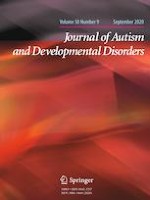17-02-2020 | Original Paper
Interactional Synchrony and Its Association with Social and Communication Ability in Children With and Without Autism Spectrum Disorder
Gepubliceerd in: Journal of Autism and Developmental Disorders | Uitgave 9/2020
Log in om toegang te krijgenAbstract
Social partners tend to coordinate their behaviors in time. This “interactional synchrony” is associated with a host of positive social outcomes, making it ripe for study in autism spectrum disorder (ASD). Twenty children with ASD and 17 typically developing (TD) children participated in conversations with familiar and unfamiliar adults. Conversations were rated for movement synchrony and verbal synchrony, and mothers completed measures regarding children’s everyday social and communication skills. Children with ASD exhibited less interactional synchrony, with familiar and unfamiliar partners, than TD peers. Beyond group-level differences, interactional synchrony negatively correlated with autism symptom severity, and predicted dimensional scores on established social and communication measures. Results suggest that disrupted interactional synchrony may be associated with impaired social functioning in ASD.
